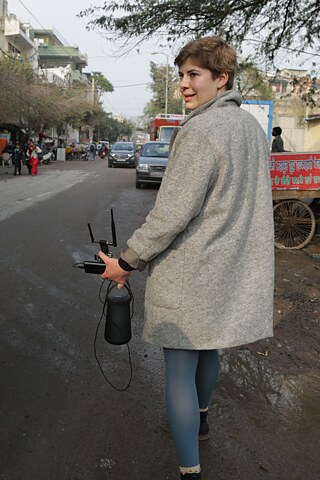Iz Paehr
bangaloREsident@NCBS
Iz Paehr works with and on structures of virtuality. Iz often collaborates on projects, they design, programme and write along questions of access, materiality and play.
One of Iz’s focus areas is metaphors and materials of networks. There are gaps between imaginations and material realities of the internet: For example, the imagery of the “cloud” is common, whereas 99% of bits are transferred via submarine cables that have landing stations predominantly situated above the equator. The latter opens questions about ownership, power and access.
During the bangaloREsidency at the Archives at the National Centre for Biological Sciences Iz will examine these questions and search for traces of the plant-based beginnings of transatlantic communications. In the making of internet infrastructures and its predecessor, the telegraph network, the plant life of India played a significant role. A latex produced from gutta-percha trees of the genus Palaquium made for an electronically nonconductive material that protected copper fibres from salt water. This made communication across oceans possible, which deepened colonial control. The trees soon faced extinction in an early technology induced ecological disaster. Which archive materials tell stories about plants and networks and how is the archive itself networked? How can alternative plant-based networks be tested? And where in Bangalore are there still/again Palaquium trees today?
Iz’s project is concerned with linking these early plant-enabled forms of networked communications and their ecological-colonial impacts with today’s internet as an 'unevenly implemented and governed global communication system'[1] that contributes to climate catastrophe. Technological development in Bangalore today is once again accompanied by the disappearance of the city's tree cover - and at the same time the city is a place of resistance towards a more just and accessible internet. What beginnings and continuities of global networks can be found, archived and narrated?
With this project, Iz builds on earlier works on networks, for example a collaboratively developed network game titled Code, Layers, Infrastructures performed with HKW at the Common Room Foundation in New Delhi[2], and the workshop <MIAU ID> with Ren Loren Britton at Control Shift, UK.[3]
[1] https://cis-india.org/raw
[2] https://archiv.hkw.de/en/programm/projekte/veranstaltung/p_161524.php
[3] https://www.control-shift.network/2020/artwork.html?artwork=MIAU_ID
One of Iz’s focus areas is metaphors and materials of networks. There are gaps between imaginations and material realities of the internet: For example, the imagery of the “cloud” is common, whereas 99% of bits are transferred via submarine cables that have landing stations predominantly situated above the equator. The latter opens questions about ownership, power and access.

Iz’s project is concerned with linking these early plant-enabled forms of networked communications and their ecological-colonial impacts with today’s internet as an 'unevenly implemented and governed global communication system'[1] that contributes to climate catastrophe. Technological development in Bangalore today is once again accompanied by the disappearance of the city's tree cover - and at the same time the city is a place of resistance towards a more just and accessible internet. What beginnings and continuities of global networks can be found, archived and narrated?
With this project, Iz builds on earlier works on networks, for example a collaboratively developed network game titled Code, Layers, Infrastructures performed with HKW at the Common Room Foundation in New Delhi[2], and the workshop <MIAU ID> with Ren Loren Britton at Control Shift, UK.[3]
[1] https://cis-india.org/raw
[2] https://archiv.hkw.de/en/programm/projekte/veranstaltung/p_161524.php
[3] https://www.control-shift.network/2020/artwork.html?artwork=MIAU_ID